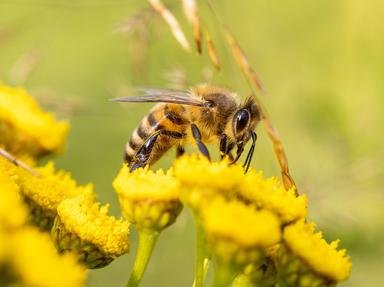Quiz Answer Key and Fun Facts
1. You're observing an open hive of giant honey bees in Nepal when you hear a fierce buzzing noise coming from behind you, heading toward the hive. Suddenly a couple of bees on the hive turn their backs on you, lift their hindquarters ninety degrees in the air, and waive their bee-hinds at you. Bees down the line follow suit one after another in a ripple effect until the whole hive surface is covered with bees doing this rude, bottoms-up version of "the wave" in your general direction. What should you do?
2. "Say, was you ever bit by a dead bee? A honey bee?" The doddering character Eddie obsesses over this idea in the the classic Bogart and Bacall film "To Have and Have Not". Leaving aside the question of whether any bees "bite," was Eddie right that you can still receive a significant sting by stepping on a dead honey bee?
3. So is it true that bees can only sting once, and then they die?
4. A beekeeper goes to visit his hive one morning and instead of the thriving colony of over a thousand honey bees he had yesterday, he finds a hive empty of all of the adult bees except the queen, the brood cells capped, and no sign of live or dead bees in the surrounding area despite searching throughout a perimeter radiating hundreds of yards from the hive. What has likely happened?
5. What unfortunate "first" distinction did American professional beekeeper David Hackenberg gain while working with his honey bees in Florida in November 2006?
6. Between 2009 and 2013, what change occurred in the cultivated honey bee population in the United States?
7. The consensus between European, Canadian and US studies published in 2013 is that Colony Collapse Disorder among western honey bees is caused by which of the following?
8. You've come out to enjoy the weather on your wooden porch one fine May day, when a big, plump, black, furry, buzzing insect dive-bombs right at you. What is it, and what do you do?
9. Which of the following does NOT rely primarily or exclusively on bee pollination?
10. Which of the following is NOT recommended as a way for lay people to aid the imperiled honey bees and other pollinator bees?
Source: Author
pmcbee
This quiz was reviewed by FunTrivia editor
guitargoddess before going online.
Any errors found in FunTrivia content are routinely corrected through our feedback system.

